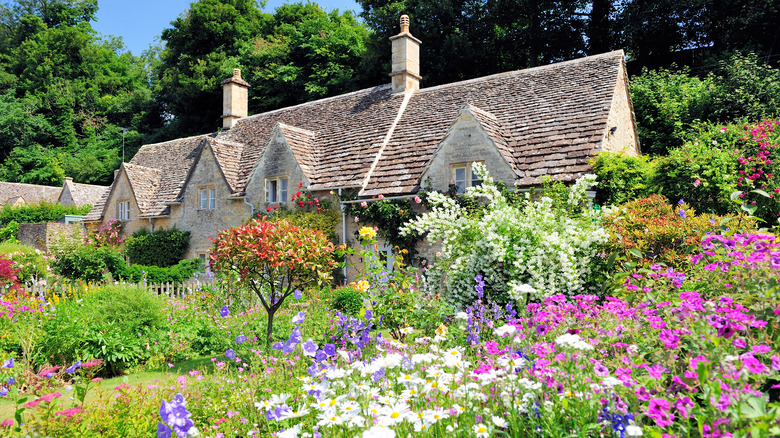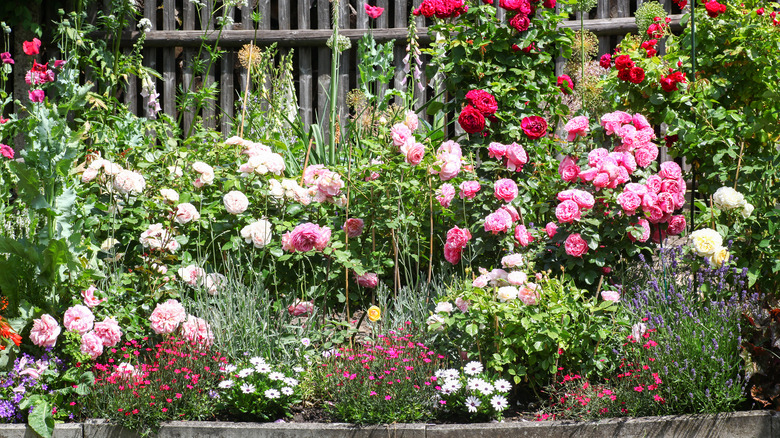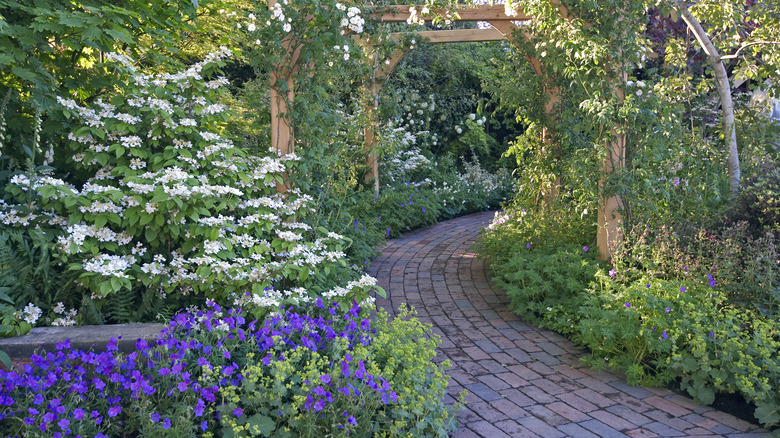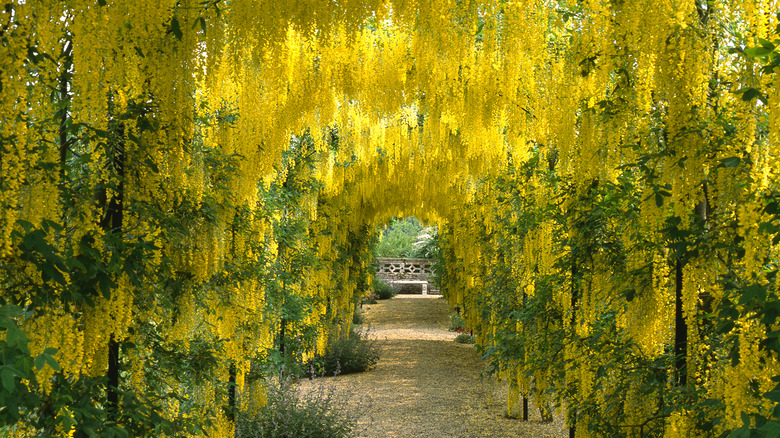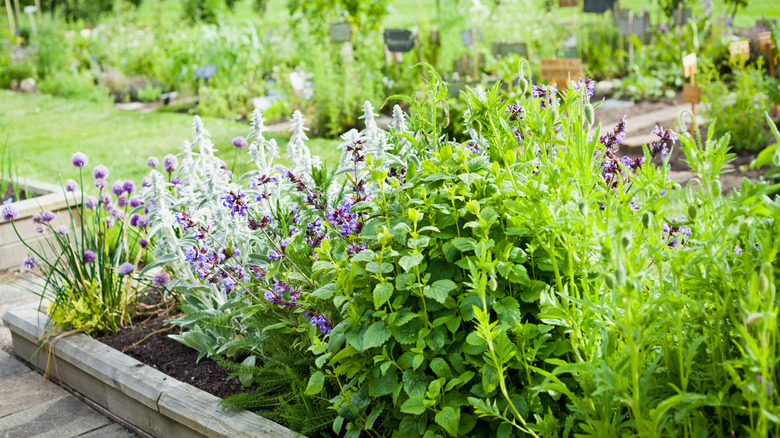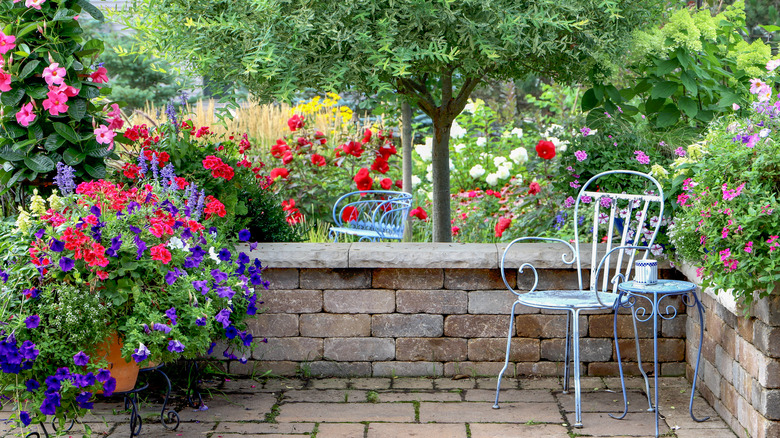How To Design And Plant The Perfect Cottage Garden
Flowers, colors, herbs, and edibles are the basics of the English cottage garden. In essence, a cottage garden is an antithesis of a formal Victorian garden: unplanned, unkempt, and chock full of all things growing willy-nilly. The original medieval cottage garden was a staple among poor farmers who lived in, well, modest cottages. They had very small plots of land, explains Discover Britain Magazine, so they used every inch of their garden in an attempt to cultivate vegetables, keep bees, and, whenever possible, grow a fruit tree or two.
Today the style is recognized for its abundance of blossoms in all colors of the rainbow, but it wasn't until the Elizabethan age that flowers were added to cottage gardens for strictly ornamental purposes. Some are set to appear at the first sign of spring while others display their showy blooms throughout summer and into fall. In a cottage garden, you can find a home for every plant in which you've ever been interested.
If you like cottagecore décor, maybe it's time to let that aesthetic flow out of the house and into the garden. There really are no rules to the cottage garden game. You can pack in as much color as you want, choose plants that self-seed and are super easy to grow, and have fun with it all. And, by fun, we mean ... don't even worry too much about the weeds that sprout up. They're all a part of the deliberately askew aesthetic.
Start with flowers
Mind your wallet when you hit up the local nursery for your first round of plants because it's way too easy to indulge in one of everything. As soon as you're clear on how much you have to spend, go for it. Find every color, size, shape, and scent that interests you, and give it a try. Different types of foliage will texturize your garden, and just think of all of the delicious fragrances you can include. Rose, honeysuckle, sweet pea, gardenia — all of these are perfect for an English cottage garden.
As you start to plant, shun the straight lines. You're not here to build an even-topped hedgerow or a precisely spaced border; in fact, you should be aiming for as little exposed soil as possible. Garden Answer (via YouTube) suggests planting large groupings closely together.
Seasonal layers are an important consideration. You're putting way too much hard work into this to-die-for garden to have it all blossom at once and fade out after just a month. For this, blend in flowers that bloom at different times of the season in order to extend the life of your garden throughout the year. Spring, summer, and fall blooming flowers should be planted close to each other with some evergreen ground covers to fill in empty spaces. That way, as soon as the crocuses and daffodils start fading, the petunias will pop up and carry the color until it's time for the dahlias and the mums to say hello.
Build winding walkways
What is waiting for your guests just around that corner? It could be more white flowers or a grove of dwarf orange trees. The delightfully unexpected is one of the hallmarks of cottage-style gardening. And what better way to lead guests there than some paving stones or natural grass-lined walkways?
Outdoor living enthusiasts at Gardening Etc. suggest that the whole point of a pathway in a cottage garden is to not simply move from one place to another, but to do so joyfully. To that end, think of what elements will bring whimsy and a sense of lightheartedness. It could be multi-colored 3-foot-tall foxgloves spilling over onto the path, inviting butterflies and bees to the party. It could be a random batch of bricks or flagstone left over from another project. You might even saw an abandoned tree trunk into thin circular slices that can be laid down and spaced out to create an all-natural walkway.
Stick to natural materials and incorporate reclaimed items where you can. Borst Landscape & Design recommends gravel, pebbles, or mulch as generally affordable options. Each comes in various colors, grades, and sizes. They're also easy to find at local garden centers and easy to work with once you get them home.
In the end, the path doesn't need to lead anywhere glorious or even meaningful, but the journey there should still be an eclectic and splendid one.
Go vertical
More than anything, English cottage gardens have a sense of diversity to them. As you walk along your pathways, your eyes should be moving around to catch glimpses of visual interest at different levels. Vertical layers add texture by breaking up the plane of sight. For instance, plants shouldn't be defined and situated in height order as they would in a standard border garden. This means the tall growers don't necessarily belong in the back row. If it's your favorite flower, display it front and center, or let it pop up from the center of a ring of something else entirely.
If you have something tall for them to train along, climbing roses would be an absolutely stunning addition. They are the perfect mix of rambunctious, sassy with those thorns, and beautiful. Can you build an arbor or install a trellis? How about mixing them in with fuchsia bougainvillea for a wave of multi-hued delight? Smaller ornamental trees are another way to add sweeping arrays of color at differing heights. A whimsical purple wisteria or a weeping red-blooming bottlebrush could be just the ticket. Oh heck, go ahead and plant them both.
Similarly, per Gardening Etc., something like laburnum, also called the golden chain tree, can be trained and trellised to create a breathtaking canopy of cascading yellow blooms, as seen in the image above. In addition to the visual layers, laburnum is a flower that will raise your nose to the perfumed air above you.
Add herbs and a few fruit trees
Original cottage gardens needed to be functional much more than they needed to be visually pleasing, and this meant including fruit trees and herbs for cooking and using as natural medicines, cleaning agents, and toiletries. Even today, a traditional English cottage garden will contain herbs and fruit trees.
Plants for a Future says the most common herbs in a traditional cottage garden included sage, thyme, hyssop, and lavender. Some could be used to dye clothing and other fabrics. Others would be put to use masking bad odors or making tea. Advice from the Herb Lady adds bee balm and echinacea to the list. Many of the plants will provide edible flowers along with the herbs themselves. They can be planted to flush out vacant spaces or huddled together to keep all of the edibles easily accessible. Because of the chaotic nature of a cottage garden and its propensity to overgrow in the best kind of way, it would behoove you to label herb seedlings so you at least have some idea of what you're serving at the table.
Apple and pear trees would have been common sights in a home garden a few hundred years ago. Cider and perry were easy-to-make staple beverages, especially when clean water was difficult to come by. Plants for a Future goes on to suggest adding berry bushes, ornamental fruit trees, and nut trees, though we might suggest sticking to the more manageable dwarf varieties.
Get ornamental
Trellises and arbors add to the vertical display, but there's much more ornamentation to be done at ground level. That whimsical pale blue bistro set you passed by at the thrift store last weekend is dying to be placed under the crabapple tree. Landscaping Network agrees. Get yourself to the second-hand store they command, and, while you're there, seek out the mismatched and the left behind, the shabby-chic wrought iron tables, and the floral patterned seat cushions that look like they came straight from your grandmother's backyard.
Sundials, gnomes, teak wooden benches. Think of wit of whimsy while you're dreamily walking through. Take a seat on a log and channel visions of "Alice in Wonderland." The most important thing about a cottage garden is that you make it truly your own. Your imagination is the only limitation when it comes to stylizing your garden to stamp it with your signature personality and charm. Maybe you're big into magical fairy gardens or statues shaped like mushrooms. Whatever you fancy, toss it into the mix and watch how your flowers grow and blossom all around it.
Finally, to create a welcoming nighttime space, consider decorating trees with lights or installing solar lights along pathways. Edison bulbs will bring a touch of the modern farmhouse vibe. String lights will keep things on the playful side.
